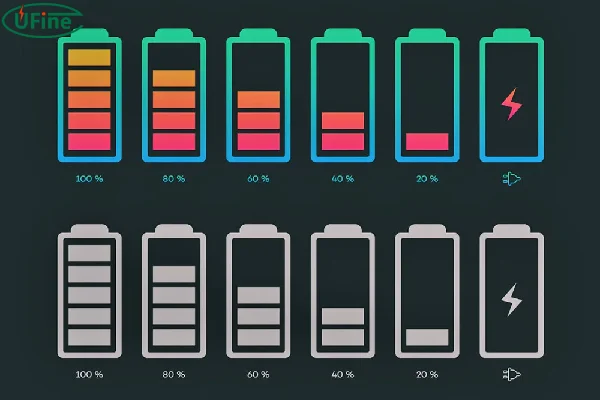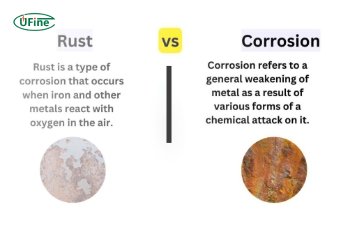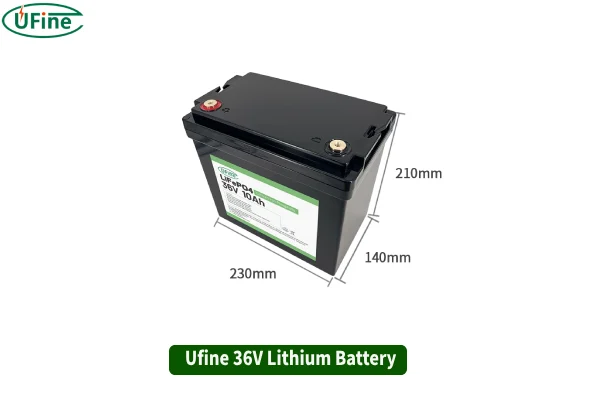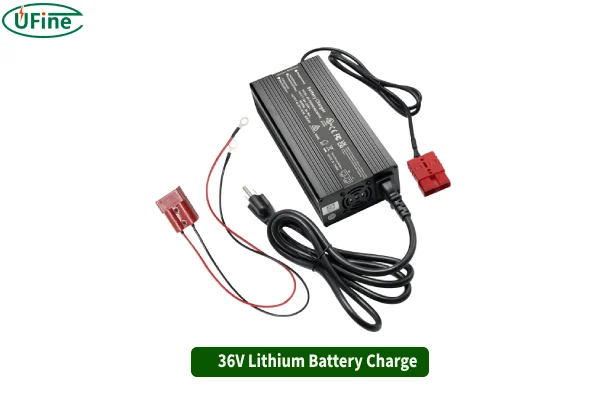
- Part 1. What is a 36V lithium battery?
- Part 2. 36V lithium battery mAh
- Part 3. Size and weight
- Part 4. Why should you choose a 36V lithium battery?
- Part 5. How long does a 36V lithium battery last?
- Part 6. What is a 36V lithium battery used for?
- Part 7. What charger is used for a 36V lithium battery?
- Part 8. How to charge a 36V lithium battery?
- Part 9. 36V lithium battery maintenance Tips
- 10. Choose the best 36V lithium battery
In today’s tech-driven world, batteries are essential. Among them, the 36V lithium battery stands out. But why is it so special? Well, they power many devices efficiently and reliably. Whether it’s an e-bike or a power tool, these batteries are the go-to choice for many. So, let’s dive into what makes the 36V lithium battery so unique and why you should consider using it for your devices.
Part 1. What is a 36V lithium battery?
A 36V lithium battery is a type of rechargeable battery that uses lithium-ion technology. These batteries are known for their high energy density, meaning they can store much power in a relatively small package. This feature makes them incredibly popular for portable devices and applications where weight and size are critical factors.
How They Power Devices
These batteries power devices by releasing stored electrical energy. Lithium ions move from the cathode to the anode when you charge the battery. The ions return when you use the battery, creating an electric current. This current powers your device. It’s like a dance of ions happening inside the battery, ensuring your devices run smoothly.
Characteristics
- High Energy Density: They can store a lot of power in a small space. So, you get more power without needing a huge battery.
- Lightweight: These batteries are much lighter than other types with similar capacities. This makes them ideal for portable devices.
- Long Lifespan: They can last for many charge cycles, which means you don’t have to replace them often.
- Fast Charging: They can be charged quickly, reducing downtime.
- Low Self-Discharge: They hold their charge well when not in use, so you don’t have to worry about them losing power quickly.
Part 2. 36V lithium battery mAh
mAh stands for milliampere-hour, and it measures the battery’s capacity. The higher the mAh rating, the longer the battery will last between charges. For instance, a 36V battery with a capacity of 10,000 mAh will last longer than one with 5,000 mAh. This is crucial when choosing a battery for your device because it directly affects how long you can use the device before needing to recharge.
Part 3. Size and weight
36V lithium batteries come in various sizes and weights, catering to different needs. Generally, they are compact and light, making them perfect for a wide range of applications.
Examples
- Small Devices: For gadgets like portable speakers or small drones, you’ll find compact batteries that are easy to carry around.
- Larger Equipment: For bigger devices like e-bikes or power tools, the batteries might be larger, but they are still lightweight compared to other types.
Part 4. Why should you choose a 36V lithium battery?
There are many reasons to choose a 36V lithium battery over other types. Let’s break down some of the key benefits:
- Efficiency: With high energy density, you get more power in a smaller size. This makes your devices more efficient.
- Portability: Being lightweight means carrying your devices around without feeling weighed down.
- Longevity: These batteries have a long lifespan, so you won’t need to replace them frequently, saving you money in the long run.
- Fast Charging: They charge quickly, so you don’t have to wait long to use your devices again. This is particularly useful for things like e-bikes or power tools.
- Low Maintenance: Unlike some other types of batteries, lithium batteries don’t require regular topping up of fluids or other maintenance tasks.
- Eco-Friendly: Because they last longer, you’ll be disposing of fewer batteries, which is better for the environment.
So, if you’re looking for a reliable, efficient, and long-lasting battery, a 36V lithium battery is a great choice.
Part 5. How long does a 36V lithium battery last?

The lifespan of a 36V lithium battery depends on several factors, including how you use it and how well you take care of it. On average, these batteries last about 2-5 years, translating to around 500-1,000 charge cycles.
Factors Affecting Lifespan
- Usage: Frequent deep discharges can shorten the battery’s life. It’s better to recharge the battery before it gets completely drained.
- Temperature: Extreme temperatures, whether hot or cold, can degrade the battery’s performance and lifespan. Try to use and store the battery in a moderate climate.
- Charging: Overcharging can harm the battery. Always use the recommended charger and unplug the battery once fully charged.
- Maintenance: Proper care and maintenance can extend the battery’s life. This includes regular charging, avoiding extreme temperatures, and keeping the battery clean.
Part 6. What is a 36V lithium battery used for?
36V lithium batteries are incredibly versatile and are used in various applications. Here are some common uses:
- Electric Bikes: These batteries provide long-lasting power for e-bikes, making them perfect for daily commutes or long rides.
- Power Tools: They offer reliable power for heavy-duty tasks, making them ideal for professionals and DIY enthusiasts.
- Marine Equipment: From trolling motors to fish finders, 36V lithium batteries are used in various marine applications.
- Solar Power Storage: They are excellent for storing energy generated by solar panels, providing a reliable power source even when the sun isn’t shining.
- Golf Carts: These batteries offer a reliable and long-lasting power source for golf carts, ensuring a smooth ride around the course.
- Home Backup Systems: They can keep essential devices running during power outages, providing peace of mind and convenience.
Part 7. What charger is used for a 36V lithium battery?
To charge a 36V lithium battery, you need a specific charger designed for lithium batteries. These chargers are built to handle the unique charging needs of lithium batteries, ensuring safe and efficient charging.
- Standard Chargers: These are good for regular charging and are typically included with the battery when you purchase it.
- Fast Chargers: These chargers can reduce charging time significantly, which is useful if you need to use your device frequently.
- Always use the charger recommended by the battery manufacturer. Using the wrong charger can damage the battery and reduce its lifespan.
Part 8. How to charge a 36V lithium battery?
Charging a 36V lithium battery is straightforward, but there are some best practices to follow to ensure safe and efficient charging.
Steps
- Connect the Charger: Plug the charger into a power outlet.
- Attach the Battery: Connect the battery to the charger. Make sure the connections are secure.
- Monitor Charging: Keep an eye on the charging indicator. Most chargers have an LED light that shows the charging status.
- Disconnect When Full: Unplug the charger once the battery is fully charged. Overcharging can damage the battery.
Tips
- Avoid Overcharging: Disconnect the charger once the battery is full to prevent overcharging, which can harm the battery.
- Charge in a Cool Place: Avoid charging the battery in extreme temperatures. It is best to charge it in a cool, dry place.
- Use the Right Charger: Always use the charger recommended by the manufacturer. Using the wrong charger can damage the battery.
Part 9. 36V lithium battery maintenance Tips
Proper maintenance can significantly extend the life of your 36V lithium battery. Here are some tips to keep your battery in top condition:
- Regular Charging: Don’t let the battery fully discharge frequently. Lithium batteries perform best when they are kept partially charged.
- Store Properly: When not in use, store the battery in a cool, dry place. Avoid storing it in extreme temperatures.
- Avoid Extreme Temperatures: Both high and low temperatures can degrade the battery’s performance. Try to keep the battery at a moderate temperature.
- Clean Contacts: Ensure the battery contacts are clean. Dirt and debris can interfere with the battery’s performance.
- Check for Damage: Regularly inspect the battery for any signs of damage. If you notice any swelling, leaks, or other issues, it’s best to replace the battery.
- By following these maintenance tips, you can ensure that your 36V lithium battery stays in good condition and lasts as long as possible.
10. Choose the best 36V lithium battery
When choosing a 36V lithium battery, there are several factors to consider to ensure you get the best one for your needs.
- Capacity (mAh): The higher the mAh rating, the longer the battery will last. Choose a capacity that fits your usage needs.
- Size and Weight: Consider the size and weight of the battery, especially if you’re using it for portable devices.
- Brand: Opt for reputable brands known for their quality and reliability.
- Reviews: Check customer reviews to see how other users have found the battery’s performance and reliability.
- Warranty: Look for batteries that come with a warranty. This can provide peace of mind and protection in case of any issues.
Choosing the right battery can make a huge difference in the performance and longevity of your devices. A 36V lithium battery offers efficiency, longevity, and versatility, making it a solid choice for a wide range of applications. Whether you need it for an e-bike, power tool, or another device, it’s a reliable and efficient option. Remember to follow proper charging and maintenance tips to get the most out of your battery. So, go ahead and power your devices with confidence!
Related Tags:
More Articles

Battery Rust vs Corrosion: Key Differences and How to Deal With Each
Learn the key differences between battery rust and corrosion, their causes, and how to fix each. Discover why lithium batteries are built to resist both issues.
Why Lithium Batteries Don’t Rust: Chemical Stability Explained
Learn why lithium batteries don’t rust. Their iron-free chemistry and moisture protection make them more corrosion-resistant than lead-acid or alkaline types.
Server Rack Battery vs UPS Battery: What’s the Difference
Discover the difference between server rack and UPS batteries. Compare design, chemistry, performance, and maintenance to select the best data center backup.
How to Choose the Right Server Rack Battery for Your Data Center?
Find out how to choose the right server rack battery for your data center. Consider capacity, runtime, safety, and compatibility for reliable backup power.
What Is a Server Rack Battery? A Complete Guide for Data Centers and IT
Discover what a server rack battery is, how it works, and why it’s essential for reliable data center and IT power backup. Learn key features and benefits.




